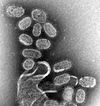Wikipedia:Today's featured article/January 1, 2007
Influenza is an infectious disease of birds and mammals caused by an RNA virus of the family Orthomyxoviridae. Typically, influenza is transmitted from infected mammals through the air by coughs or sneezes, creating aerosols containing the virus, and from infected birds through their droppings. Infections occur through contact with these bodily fluids or with contaminated surfaces. Flu viruses can remain infectious for over 30 days at 0°C (32°F), about one week at human body temperature, and indefinitely at very cold temperatures. Flu spreads around the world in seasonal epidemics, killing millions of people in pandemic years and hundreds of thousands in non-pandemic years. Three influenza pandemics occurred in the 20th century—each following a major genetic change in the virus—and killed tens of millions of people. Often, these pandemics result from the spread of a flu virus between animal species. Since it first killed humans in Asia in the 1990s a deadly avian strain of H5N1 has posed the greatest influenza pandemic threat. Vaccinations against influenza are most common in high-risk humans in industrialised countries and farmed poultry. The most common human vaccine is the trivalent flu vaccine that contains purified and inactivated material from three viral strains. (more...)
Recently featured: Maraba Coffee – Kroger Babb – Redshift

